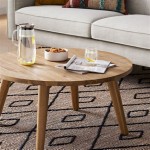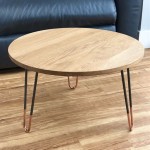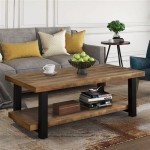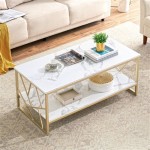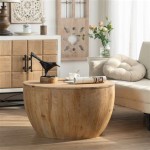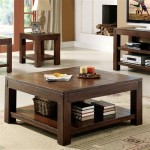Mid-Century Scandinavian Coffee Table: A Timeless Icon
The mid-century Scandinavian coffee table represents a significant chapter in furniture design history, embodying principles of functionalism, minimalism, and organic aesthetics. Characterized by clean lines, natural materials, and a subdued color palette, these tables have maintained their relevance and desirability for decades, continuing to complement various interior design styles. This article delves into the key attributes, historical context, and enduring appeal of the mid-century Scandinavian coffee table.
The Defining Characteristics of Mid-Century Scandinavian Coffee Tables
Mid-century Scandinavian design, flourishing roughly from the 1930s to the 1960s, emphasized simplicity and practicality. This ethos is clearly reflected in the design and construction of coffee tables from this era. These tables are not merely functional surfaces; they are often considered works of art, showcasing the beauty of natural materials and thoughtful craftsmanship.
One of the most prominent features of these coffee tables is the use of natural materials, primarily wood. Teak, oak, and rosewood were commonly employed, prized for their durability, distinctive grains, and warm tones. The wood was often finished with oil or wax, enhancing its natural beauty and providing a tactile quality. These finishes allowed the wood to "breathe," aging gracefully and developing a rich patina over time.
The shapes of mid-century Scandinavian coffee tables are typically geometric, with an emphasis on clean lines and simplicity. Rectangular, square, and circular designs were prevalent, often featuring gently tapered legs that contribute to an airy and elegant appearance. Avoidance of excessive ornamentation is a hallmark of this design movement. Ornamentation is replaced by the inherent beauty of the material and the purity of the form.
Functionality is another critical element. These coffee tables were designed to be practical and versatile, serving as a focal point in the living room while providing ample surface area for beverages, books, and other items. Some designs incorporate additional features like lower shelves for added storage, further enhancing their utility.
Attention to detail is evident in every aspect of these tables, from the joinery techniques used to the subtle curves and angles of the legs and edges. Designers often prioritized quality craftsmanship, ensuring that each piece was built to last. This dedication to quality has contributed significantly to the longevity and collectability of these items.
The color palette of mid-century Scandinavian coffee tables is generally restrained, focusing on natural wood tones and neutral hues. Lighter woods like birch and beech were sometimes used, often paired with darker accents or contrasting materials. The overall effect is one of understated elegance and timeless appeal.
Historical Context and Influential Designers
The mid-century Scandinavian design movement emerged in the post-World War II era, driven by a desire for affordable, well-designed furniture that could improve the quality of life for everyday people. In the wake of the war, there was a move away from complex, ornate designs towards simpler, more functional forms.
Scandinavian countries, including Denmark, Sweden, Norway, and Finland, became central hubs for this design movement. These countries had a long tradition of craftsmanship and a strong connection to nature, which influenced the design principles and aesthetic values of the era.
Several influential designers played a key role in shaping the aesthetic of mid-century Scandinavian coffee tables. Hans Wegner, a Danish designer, is renowned for his innovative and sculptural furniture designs. His coffee tables often featured organic forms and meticulous attention to detail. Finn Juhl, another prominent Danish designer, created pieces that were characterized by their elegant curves and sophisticated use of materials. His contributions helped to define the modern Danish design aesthetic.
Other notable designers include Arne Jacobsen, known for his minimalist designs and functional approach, and Børge Mogensen, who focused on creating practical and affordable furniture for the home. These designers, along with many others, contributed to the widespread popularity of mid-century Scandinavian design.
The influence of the Bauhaus movement, with its emphasis on functionalism and simplicity, also played a role in shaping the aesthetic of mid-century Scandinavian design. Scandinavian designers sought to create furniture that was both beautiful and practical, reflecting the needs and values of modern living.
The availability of high-quality wood and the skilled craftsmanship of Scandinavian artisans allowed designers to bring their visions to life. The use of traditional joinery techniques, such as dovetail joints and mortise-and-tenon joints, ensured the durability and longevity of these pieces.
Magazines and exhibitions helped to promote mid-century Scandinavian design internationally, showcasing the beauty and functionality of these pieces to a wider audience. As a result, mid-century Scandinavian furniture, including coffee tables, became highly sought after by collectors and design enthusiasts around the world.
The Enduring Appeal and Integration into Modern Interiors
The mid-century Scandinavian coffee table has maintained its appeal for several reasons. Its timeless design transcends fleeting trends, allowing it to seamlessly integrate into various interior styles, from minimalist and modern to eclectic and bohemian.
The emphasis on natural materials and craftsmanship creates a sense of warmth and authenticity, adding a touch of organic beauty to any space. The understated elegance of these tables makes them versatile enough to complement a wide range of furniture and decor.
The focus on functionality ensures that these coffee tables are not only visually appealing but also practical for everyday use. The ample surface area and thoughtful design make them ideal for serving as a focal point in the living room.
The durability and longevity of mid-century Scandinavian coffee tables also contribute to their enduring appeal. Built to last, these pieces can withstand the test of time and become treasured heirlooms.
Integrating a mid-century Scandinavian coffee table into a modern interior is relatively straightforward. Its clean lines and neutral color palette make it easy to pair with other furnishings. It can be used to add a touch of warmth and sophistication to a minimalist living room or to complement the eclectic style of a more bohemian space.
When choosing a mid-century Scandinavian coffee table, it is important to consider the overall style and scale of the room. A rectangular table may be suitable for a larger space, while a circular or square table may be more appropriate for a smaller area. The wood type and finish should also be considered to ensure that the table complements the existing furniture and decor.
To enhance the aesthetic appeal of a mid-century Scandinavian coffee table, consider styling it with a few carefully chosen accessories. A vase of flowers, a stack of books, or a decorative tray can add visual interest without overwhelming the table's clean lines. Avoid cluttering the surface with too many items, as this can detract from the table's minimalist aesthetic.
The timeless design of mid-century Scandinavian coffee tables ensures that they will continue to be a sought-after addition to any home. Their combination of form, function, and craftsmanship makes them a true icon of furniture design, representing a legacy of simplicity and elegance.
The value of authentic mid-century Scandinavian coffee tables has generally increased over time, making them a worthwhile investment for collectors and design enthusiasts. When purchasing a vintage piece, it is important to carefully inspect the construction, finish, and any markings or labels that may indicate the designer or manufacturer. Reputable dealers and auction houses can provide valuable information and authentication services.
The enduring appeal of the mid-century Scandinavian coffee table lies in its ability to transcend trends and seamlessly integrate into various design styles. Its focus on functionalism, natural materials, and impeccable craftsmanship ensures that it will remain a design classic for generations to come. Its minimalist elegance proves that beauty can be found in simplicity and that well-designed objects can truly enhance the quality of everyday life.

Scandinavian Mid Century Modern Coffee Table Minimalist Singapore

Mid Century Modern Scandinavian Surfboard Coffee Table With Shelf Galerie Møbler

Mid Century Coffee Table Solid Wood Rectangle Scandinavian Black Walnut Sofa

Mid Century Modern Scandinavian Teak Coffee Table 1950s For At Pamono

Mid Century Coffee Table Vintage Storage Unit Scandinavian Nordic Shelf Drawer Unique Home Furniture

Mid Century Modern Scandinavian Coffee Table In Teak And Oak Galerie Møbler

Vintage Sven Aage Eriksen Coffee Table Noden Original Scandinavian Furniture

Bentley Designs Dansk Scandi Oak Coffee Table With Shelf Haskins Furniture

Scandinavian Coffee Table Mid Century Modern Style Vintage Storage Drawer Shelf

Vintage Danish Coffee Table In Teak Noden Original Scandinavian Furniture
